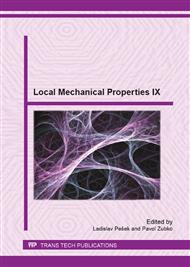p.72
p.79
p.83
p.87
p.91
p.96
p.100
p.104
p.108
Change in Mechanical Properties of Weld Claddings after Cyclic Thermal Loading
Abstract:
This contribution deals with the analysis of the renovation layer quality of continuous casting steel rollers, developed through the submerged arc surfacing method (SAW). The continuous casting roller was analysed through the degradation phenomena which act during the operation. Four kinds of filler materials were used for the renovation of the worn roller. Surfacing was carried out as a three-layer in order to eliminate the need for intermediate layer formation. The quality of weld deposits was evaluated in terms of the structure and microhardness after thermal cyclic loading. The best properties showed newly developed filler material W8-WLDC8 from point of view of the microhardness.
Info:
Periodical:
Pages:
91-95
Citation:
Online since:
September 2013
Authors:
Price:
Сopyright:
© 2014 Trans Tech Publications Ltd. All Rights Reserved
Share:
Citation:


